Smallest Arduino Boards for your Mini Arduino Projects
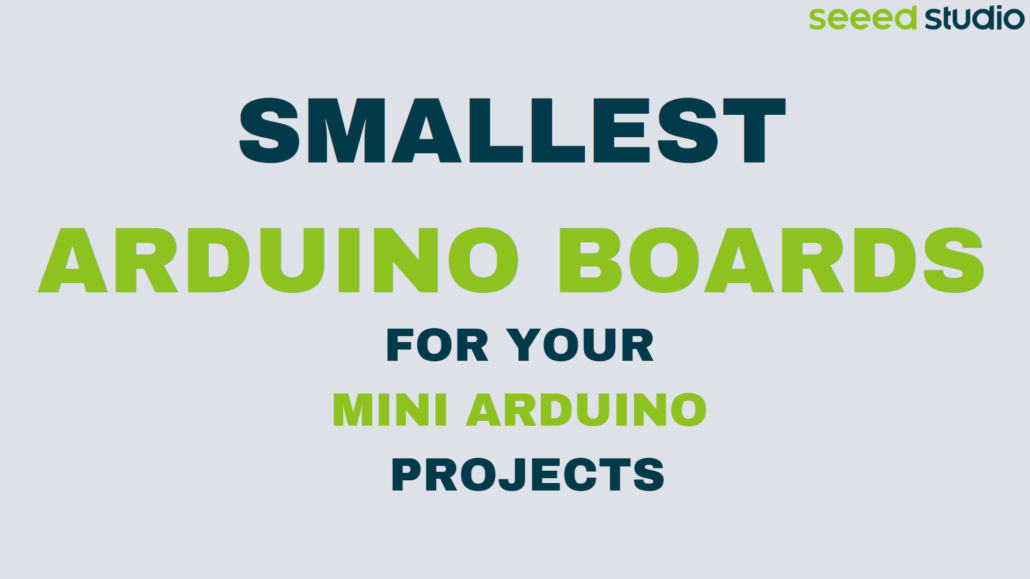
Looking for small Arduino boards for your mini Arduino projects? Want to create a wearable device with an Arduino? Arduino board too big? Tiny Arduino board not powerful enough and not functional due to its size?
If all your answers to the above answers are all yes, this guide will be just for you! We have compiled various smallest Arduino boards out there into a list for you to pick from which you can use to integrate into nearly any mini Arduino project, from robots to wearables.
We will also include a few mini Arduino projects to show you what the tiny Arduino boards can do as well!
Without further ado, let us look at the various tiny boards which you can use to minimize your Arduino projects with:
Arduino Nano v3 (45x18mm, $19.80)
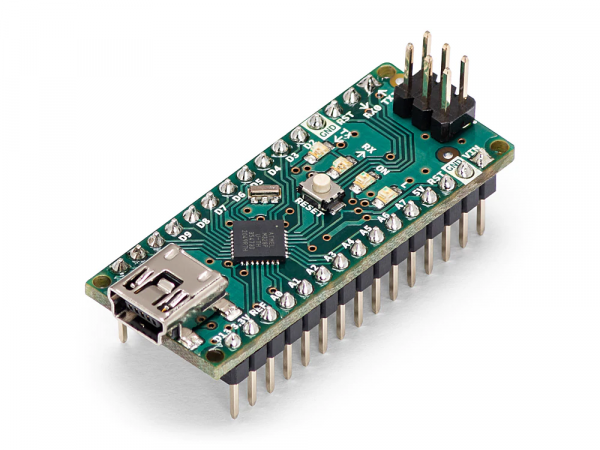
Coming in first, the Arduino Nano is a small, complete, and breadboard-friendly board based on the ATmega328. It has more or less the same functionality as the Arduino Duemilanove but in a different package. It lacks only a DC power jack and works with a Mini-B USB cable instead of a standard one.
Specs:
| Specs | Arduino Nano v3 |
| Microcontroller | ATmega328 |
| Operating Voltage | 5 V |
| Digital I/O Pins | 14 |
| PWM Enable Pins | 6 |
| Analog I/O pins | 8 |
| Flash Memory | 32 KB (2 KB used by bootloader) |
| SRAM | 2 KB |
| EEPROM | 1 KB |
| Clock Speed | 16 MHz |
| Size | 45 mm x 18 mm |
| Price | $19.80 |
Arduino Micro (48x18mm, $18.90)
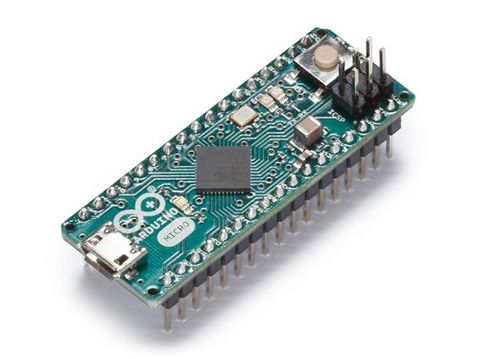
Coming up next, we have the Arduino Micro. The Micro is slightly bigger than the Nano, measuring 48mm x 18mm, and has been designed similarly to fit on a solderless breadboard. Also, it is powered by the ATmega32U4, which is different from the Nano.
Compared to the Nano, the Micro comes with more peripherals for your project needs. With 20 digital I/O pins, 12 analog inputs, and 7 PWM-enabled pins. In addition, with a native USB, you can use it easily as a mouse or keyboard. However, the Micro bootloader can only be programmed with a USB that requires a special driver. With Linux, only a few selective versions have the needed driver.
Similar to how the Nano is a shrunk-down version of UNO, the Micro is the shrunk-down version of Arduino Leonardo.
Specs:
| Specs | Arduino Micro |
| FPGA | ATmega32u4 |
| Operating Voltage | 5 V |
| Digital I/O Pins | 20 |
| PWM Enabled Pins | 7 |
| Analog I/O pins | 12 |
| Flash Memory | 32 KB (4KB used by bootloader) |
| SRAM | 2.5 MB |
| EEPROM | 1 KB |
| Clock Speed | 16 MHz |
| Size | 48 mm x 18 mm |
| Price | $18.90 |
Arduino UNO Mini Limited Edition (34.2×26.7mm, $45.00)
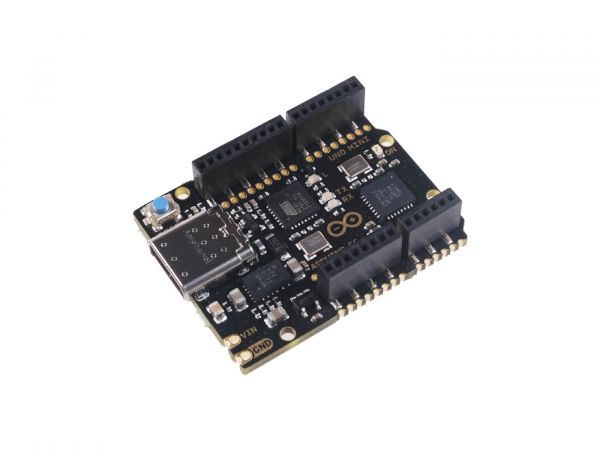
Next up, we have the smallest Arduino board on this list! Each Arduino UNO Mini Limited Edition has a unique number printed on the PCB and was made to celebrate the Arduino community on its most iconic board, the Arduino UNO. It has a Black and gold finish, elegant design and packaging, all delivered to the highest standard!
The Arduino UNO Mini Limited Edition functions exactly as the classic Arduino UNO, thus it can be very easily integrated and used in any UNO project. It uses the same ATmega328P microcontroller and the same USB-Serial Processor, ATmega16U2, but differs in size and peripherals, such as having a USB-C connector and half the female header pins. It also doesn’t feature a barrel plug connector for an external power supply, instead, there are two pins available, “VIN” and “GND” for external power supply connection.
Specs:
| Specs | Arduino UNO Mini Limited Edition |
| Microcontroller | ATmega328P |
| Operating Voltage | 5 V |
| Digital I/O Pins | 14 |
| PWM Enabled Pins | 6 |
| Analog I/O pins | 6 |
| Flash Memory | 32 KB |
| SRAM | 2 KB |
| EEPROM | 1 KB |
| Clock Speed | 16 MHz |
| Size | 34.2 mm x 26.7 mm |
| Price | $18.90 |
Arduino Nano RP2040 Connect (45x18mm, $25.50)
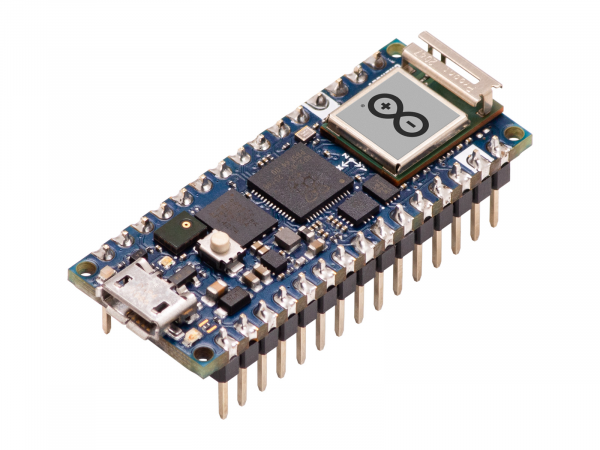
Lastly from the Arduino family, the Arduino Nano RP2040 Connect brings the famed Raspberry Pi RP2040 microcontroller to the Nano form factor. With a dual-core 32-bit Arm Cortex-M0+ processor and U-Blox Nina W102 module, you are able to design IoT projects with Bluetooth and WiFi connectivity.
It also boasts a 6-axis IMU and a powerful co-processor, ATECC608A, which allows you to dive further into real-world projects and develop robust embedded AI solutions with minimal effort!
However, unlike the Uno and many small Arduino boards, they cannot connect to Arduino shields but have pin headers, making them suitable for breadboard prototyping or in PCBs with a socket.
The Pro Mini comes in two varieties 5V/16MHz and 3.3V/8MHz where the 5V runs at the same voltage and speed as the Arduino Nano and Micro. With the 3V board, speed is slower and consumes lesser power which makes your board easy to power with batteries.
Specs:
| Specs | Arduino Nano RP2040 |
| Microcontroller | RP2040 |
| Operating Voltage | 3.3 V |
| Digital I/O Pins | 20 |
| PWM Enabled Pins | 20 (Except A6, A7) |
| Analog I/O pins | 8 |
| Flash Memory | 16 MB |
| SRAM | 264 KB |
| EEPROM | – |
| Clock Speed | 133 MHz |
| Size | 45 mm x 18 mm |
| Price | $25.50 |
Seeeduino Nano (45x18mm, $7.60)

Last but not the least, the Seeeduino Nano is a compact board similar to the Seeeduino V4.2/Arduino UNO, and it is fully compatible with Arduino Nano on pinout and sizes. Furthermore, if you have a code from your previous Uno project, you can easily move it to the Nano!
Operating at 16 MHz with 32KB of program memory, 2KB of RAM, 14 digital I/O, 6 analog inputs, and both 5V and 3.3V rails, the Seeeduino Nano is packed with peripherals for its size. It has more or less the same functionality as the Arduino Duemilanove but in a different package. Furthermore, it has a Grove I2C connector where with the help Grove system, you can play with hundreds of sensors and actuators simply by plugging. It has also a Type-C USB which is symmetrical and reversible instead of a mini USB.
Why not use an Arduino Nano?
Well, first of all, it would be the price. At only $7.60, you can get yourself a Seeeduino Nano instead of spending $22 for an Arduino Nano. In addition, you get more peripherals on the Seeeduino board as well. You basically get more for less!
Not enough peripherals?
If you feel like the Seeeduino still does not have enough peripherals for your mini project, you can check out our Grove Shield for Arduino Nano:

With 3 Grove digital connectors, 3 Grove analog connectors, 1 Grove I2C connector, and 1 Grove UART connector, these Grove interfaces are definitely more than enough for your projects. If you still need more, you can also use our Grove – I2C Hub.
Curious about what the Seeeduino Nano can be used for? Check out 20 Best Arduino Nano Projects that you must try now to see what the Nano can do!
Tech Specs:
| Specs | Seeeduino Nano |
| Microcontroller | ATmega328 |
| Operating Voltage | 5 V |
| Digital I/O Pins | 14 |
| PWM Enable Pins | 6 |
| Analog I/O pins | 8 |
| Flash Memory | 32 KB |
| SRAM | 2 KB |
| EEPROM | – |
| Clock Speed | 16 MHz |
| Size | 45 mm x 18 mm |
| Price | $7.60 |
Seeed XIAO ESP32C6 (21×17.5mm, $5.20)

XIAO ESP32C6 is a cost-effective MCU based on Espressif’s ESP32-C6. This compact MCU excels in Matter-compliant smart home applications with its support for various wireless connectivity (2.4GHz Wi-Fi 6, BLE 5.0, Zigbee, and Thread). Designed with the thumb-size footprint and a single-sided mount of the XIAO Series, it’s perfect for space-limited projects. Encrypted on the chip, the XIAO ESP32C6 ensures a desired level of security streamlined development experience, and swift market entry by integrating easily with major IoT Cloud platforms.
Features:
- Enhanced Connectivity: Combines 2.4GHz Wi-Fi 6 (802.11ax), Bluetooth 5(LE), and IEEE 802.15.4 radio connectivity, allowing you to apply the Thread and Zigbee protocols.
- Matter Native: Supports building Matter-compliant smart home projects thanks to its enhanced connectivity, achieving interoperability
- Security Encrypted on Chip: Powered by ESP32-C6, it brings enhanced encrypted-on-chip security to your smart home projects via secure boot, encryption, and Trusted Execution Environment (TEE)
- Outstanding RF performance: Has an on-board antenna with up to 80m BLE/Wi-Fi range, while reserving an interface for external UFL antenna
- Leveraging Power Consumption: Comes with 4 working modes, with the lowest being 15 μA in deep sleep mode, while also supporting lithium battery charge management.
- Classic XIAODesigns: Remains the classic XIAO designs of the thumb-size form factor of 21 x 17.5mm, and single-sided mount, making it perfect for space-limited projects such as wearables
Hardware Pinout:
Specs:
| Specs | Seeed XIAO ESP32C6 |
| Microcontroller | ESP32-C6 |
| Digital I/O Pins | 11 |
| PWM Enabled Pins | 11 |
| Analog I/O pins | 4 |
| Flash Memory | 4 MB |
| SRAM | 512 KB |
| Clock Speed | 160 MHz |
| Size | 21 mm x 17.5 mm |
| Price | $5.20 |
Seeed XIAO RP2040 (21×17.5mm, $5.40)
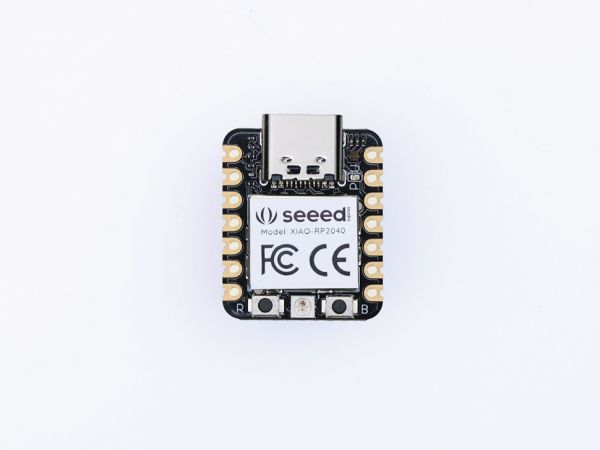
Seeed Studio XIAO RP2040 is powered by an RP2040 microcontroller chip designed by Raspberry Pi. Flexible I/Os, 264KB RAM, and dual-core are all realized in a thumb-size Arduino-compatible board. It can work as a beating heart for DIY Keyboards, tiny wearable devices, and all the projects that need mini Arduino. Tiny but Mighty!
Features:
- High Performance: Powered by RP2040, dual-core ARM Cortex M0+ processor, flexible clock running up to 133 MHz, 264KB of SRAM, and 2MB of onboard Flash memory
- Easy Development: Supports Arduino / Micropython / CircuitPython
- Multiple interfaces: 11 digital pins, 4 analog pins, 11 PWM Pins,1 I2C interface, 1 UART interface, 1 SPI interface, 1 SWD Bonding pad interface
- Suitable for Micro machine learning: With two fast cores, plenty of on-chip RAM, and a port of TensorFlow Lite, RP2040 is a great platform for machine learning applications.
- Designed for production: Breadboard-friendly & SMD design, no components on the back
Hardware Pinout:

The onboard interfaces are enough for developing multiple applications, such as wearable devices, USB development, DIY keyboard, etc. It also has no components on the back, is breadboard-friendly, and SMD design, making it easy to use for projects.
Specs:
| Specs | Seeed XIAO RP2040 |
| Microcontroller | RP2040 |
| Operating Voltage | 3.3 V |
| Digital I/O Pins | 11 |
| PWM Enabled Pins | 11 |
| Analog I/O pins | 4 |
| Flash Memory | 2 MB |
| SRAM | 264 KB |
| EEPROM | – |
| Clock Speed | 133 MHz |
| Size | 21 mm x 17.5 mm |
| Price | $5.40 |
Seeed XIAO SAMD21 (21×17.5mm, $5.40)

Features:
- Powerful performance
- Super cost-effective
- Ultra-small size
- Stable supply
- Perfect for mini Arduino projects
- Rich and complete tutorial
With a smaller footprint and faster speed compared to most Arduino boards here, the Seeed Studio XIAO SAMD21 is perfect for integrating into almost any project from wearables to small robots.
Standing at only 21 x 17.5mm, this board is as small as your thumb. It is an Arduino microcontroller that is embedded with the SAMD21 microchip with rich interfaces allowing it to be capable of being a tiny Dev. Board as well.
Hardware Pinout:
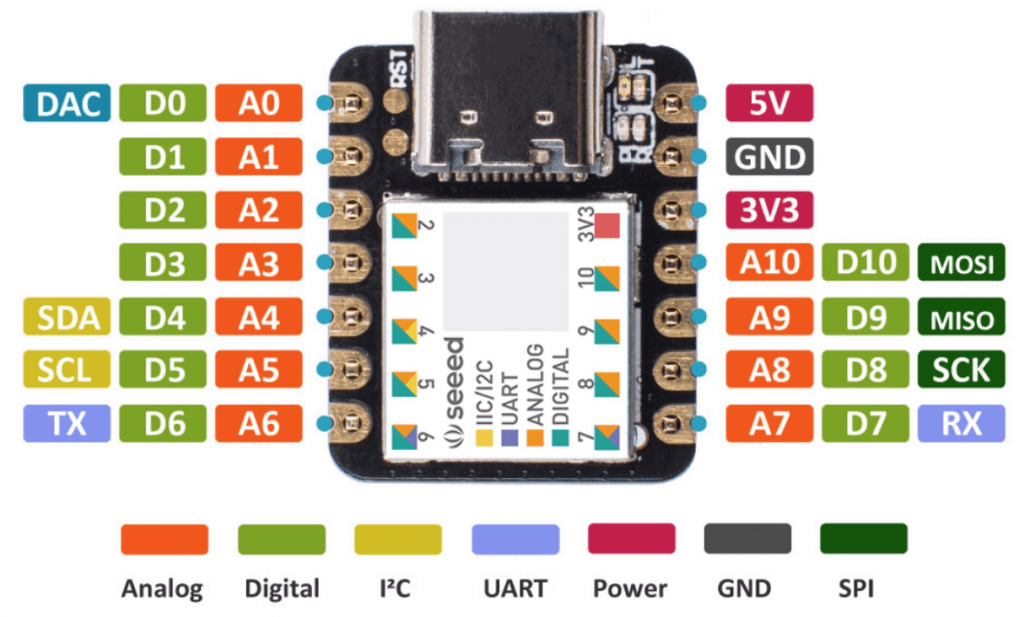
Apart from the strong CPU, Seeed Studio XIAO SAMD21 is excellent in many other functions. Despite being this small size, it has 14 GPIO PINs, which can be used for 11 analog PINs, 11 digital PINs, 1 I2C interface, 1 UART interface, and 1 SPI interface. Some PINs have various functions, A1/D1 to A10/D10 Pins have PWM functions and Pin A0/D0 has a function of DAC which means you can get true analog signals, not PWM signals when you define it as an analog pin, that’s why 14 GPIO PINs can realize more I/O PINs and interfaces. The board is also breadboard compatible which is very rare for a small board like this!
The best news is, you can get all features packed on a tiny board for only $5.40! Wow!
Specs:
| Specs | Seeed XIAO SAMD21 |
| Microcontroller | ATSAMD21 |
| Operating Voltage | 3.3 V |
| Digital I/O Pins | 11 |
| PWM Enabled Pins | 10 |
| Analog I/O pins | 11 |
| Flash Memory | 256 KB |
| SRAM | 32 KB |
| EEPROM | – |
| Clock Speed | 48 MHz |
| Size | 21 mm x 17.5 mm |
| Price | $5.40 |
Seeed XIAO ESP32C3 (21×17.5mm, $4.99)
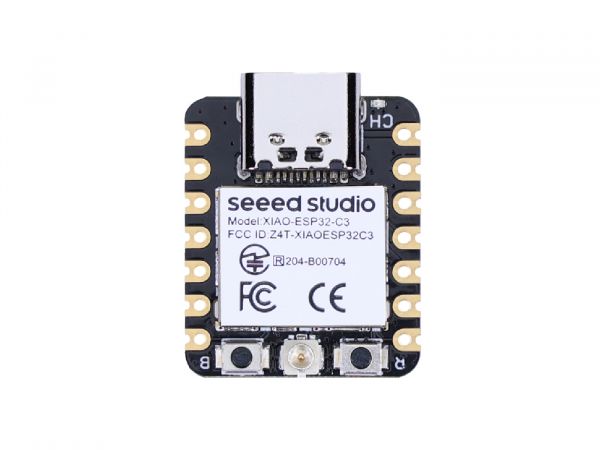
Seeed Studio XIAO ESP32C3 is the latest and cheapest in the XIAO series, priced at $4.99. If you are looking for the cheapest Arduino boards, then look no further! It is equipped with a highly-integrated ESP32-C3 chip and built around a 32-bit RISC-V chip processor with a four-stage pipeline that operates at up to 160 MHz.
Hardware Pinout:

The chip has been installed with a complete 2.4GHz Wi-Fi subsystem which means it supports Station mode, SoftAP mode, SoftAP & Station mode, and promiscuous mode for multiple WiFi applications. It works under an ultra-low power state, also supporting features of Bluetooth 5.0 and Bluetooth mesh. There are 400 KB SRAM & 4 MB Flash on the chip, allowing for more programming space and bringing more possibilities to the IoT control scenarios. For example, it is nice to add an ultrasonic distance sensor to measure the car-to-door distance and an OLED screen to check the status of the garage.
Thanks to the tiny size of the XIAO series, it is also suitable to make the wearable devices, such as a small pet tracker. This wearable device can be used as a simple GPS-Tracker which will lock its current location and publish other data.
Specs:
| Specs | Seeed XIAO ESP32C3 |
| Microcontroller | ESP32-C3 |
| Operating Voltage | 3.3 V |
| Digital I/O Pins | 11 |
| PWM Enabled Pins | 11 |
| Analog I/O pins | 4 |
| Flash Memory | 4 KB |
| SRAM | 400 KB |
| EEPROM | – |
| Clock Speed | 160 MHz |
| Size | 21 mm x 17.5 mm |
| Price | $4.99 |
Seeed XIAO nRF52840 & nRF52840 Sense (21×17.5mm, $9.90/15.99)
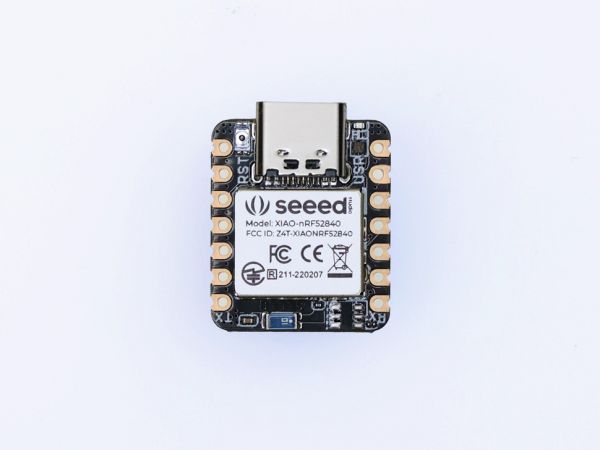
As the first wireless product in the Seeed XIAO family, Seeed XIAO nRF52840 & nRF52840 Sense has equipped with the powerful Nordic nRF52840 MCU, which is designed in a Bluetooth 5.0 module and built around a 32-bit ARM® Cortex™-M4 CPU with Floating-Point Unit (FPU) operating at 64Mhz.
Features:
- Powerful CPU (Nordic nRF52840)
- Low Power Consumption and Prolonged Use Time: 5 μA, deep sleep model and Support lithium battery charge management
- Onboard digital microphone and Onboard (Exclusive for XIAO BLE SENSE)
- Various Wireless Connectivity Options: Bluetooth 5.0, NFC, and ZigBee module with onboard antenna
- Multiple interfaces: Breadboard-friendly & SMD design, no components on the back
- Designed for production: Breadboard-friendly & SMD design, no components on the back
- Comprehensive certificates: CE | FCC | MIC
With the capability of wireless connection, they still remain the Seeed XIAO series classic form-factor of small and exquisite, which can be used for wearable devices and IoT projects.
Hardware Pinout:

1 Reset button, 1 3-in-one LED, 1 Charge LED, and 1 Bluetooth antenna are on board, allowing developers to debug their code very easily.
Note: 6 Dof IMU and PDM Microphone are only available on XIAO BLE SENSE.
Specs:
| Specs | XIAO nRF52840 / nRF52840 Sense |
| Microcontroller | Nordic nRF52840 |
| Operating Voltage | 5 V |
| Digital I/O Pins | 11 |
| PWM Enabled Pins | 11 |
| Analog I/O pins | 6 |
| Flash Memory | 2 MB |
| SRAM | 256 KB |
| EEPROM | – |
| Clock Speed | 64 MHz |
| Size | 21 mm x 17.5 mm |
| Price | $9.90 / 15.99 |
To summarize, XIAO is a series of thumb-sized Arduino-like development boards. It is one of the smallest microcontroller boards available at a very affordable price. Powered by rich accessories, detailed courses, and various project tutorials, you can quickly enter the Arduino world with it! Check more details here!
An elaborate comparison table can be found below. So, pick the one that suits you the best!
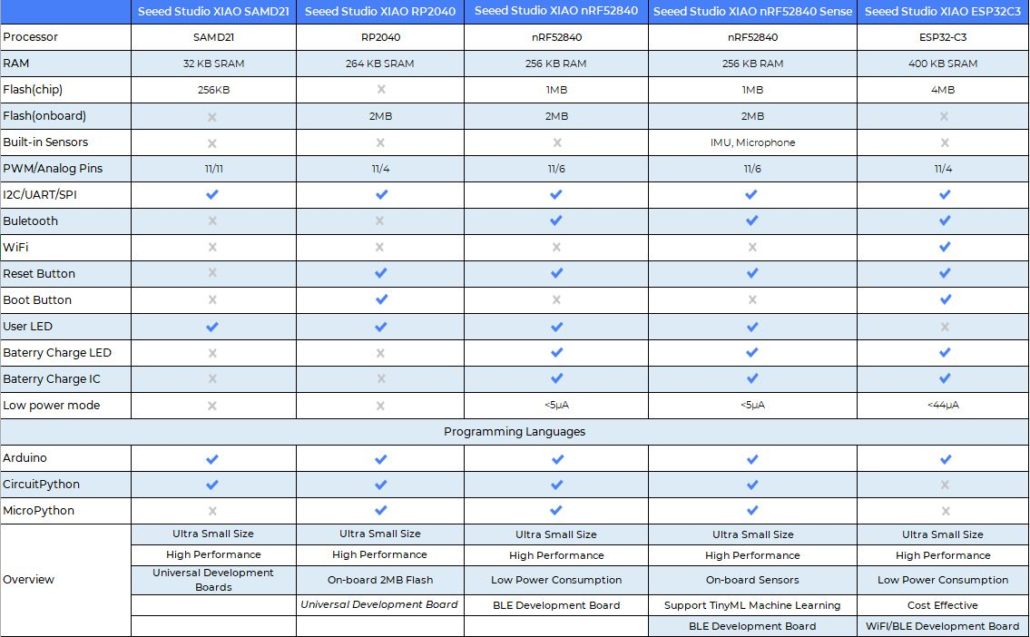
Here are some compatible Accessories for XIAO Series to help you start to build your own project quickly and efficiently!
Grove Starter Kit for Seeed XIAO
- Expand the abilities of XIAO series dev board
- 9 Grove modules
- 20 key-mini controller, LED Pack
- Attach specific XIAO series courses
- Easy debug and RESET button
- 0.96″ OLED
- No soldering needed
- Circuit Python supported
- Mini size, half of Raspberry Pi 4
- On-board lithium battery charging & management
- Grove connectors (Grove IIC*2, Grove UART*1), all 14 GPIO led out
- Compact & breakable
- SPI-flashing bonding pad reserved
- On-board power switch & charging status indicator light
Arduino-Based Mini Projects
Do not know what you can do with these tiny Arduino boards? Fret not, as here are some mini projects to get you started!
Arduino Nano Wearable Heart Rate Monitor
Smartwatches tend to be on the pricy side, so why not make one yourself with an Arduino Nano? With its small size, it can easily integrate into wearable projects like this!
What do you need?
- Seeeduino Nano / Arduino Nano v3
- uECG device
- 2.4G WIRELESS MODULE NRF24L01+PA
- Grove – RGB LED Ring
- LiPo Battery
Interested? You can find the full tutorial by Dmitry Dziuba on Arduino Project Hub!
Home Automation Project
With these small Arduino boards, they are very easy to embed into any system like this home automation example. With this project, you can now control home appliances with the help of Siri and Apple HomeKit.
What do you need?
- Arduino Micro
- Raspberry Pi Zero W
- Espressif ESP8266 ESP-01
- Suitch Software
- Apple HomeKit software
- Apply Siri Software
- Google Now Software
Interested? You can find the full tutorial by Andres Santos on Arduino Project Hub!
Arduino Doorbell

With this project, you can connect your door to the cloud and open it from everywhere. In addition, it will also play a song when the door opens!
What do you need?
- Arduino MKR1000 (or Seeeduino Nano)
- Mono Enclosed Speaker 2W 6 Ohm
- Grove – Button
- SD Breakout board
- 3D Printer
- Arduino Cloud
- Arduino Web Editor
Interested? You can find the full tutorial by Arduino_Genuino on Arduino Project Hub
Pocket-Sized Touch Keyboard

With the small size of these boards, you can make various small Arduino-based devices or wearables! For this project, we will be making a device that can perform different keyboard operations through capacitive touch sensing.
What do you need?
- Arduino Micro
- Jumper Wires
- Resistor 1M Ohm
- Soldering Iron (Generic)
Interested? You can check out the full tutorial by Amal Mathew on Arduino Project Hub.
Summary
What do you think of these smallest Arduino boards? What would you use them for? Which one is your favorite?
Let us know in the comments down below!
Interested in more Arduino projects? Here are some guides for you to follow or get inspiration!
- What is Arduino?: Overview and How to Get Started
- 40 Awesome Arduino Projects That You Must Try 2022
- 27 Arduino LED Projects you need to try!
- Arduino Ultrasonic Sensor Overview and Tutorial
- PIR Sensor: Overview, Applications and Projects
- What is IMU Sensor and How to use with Arduino